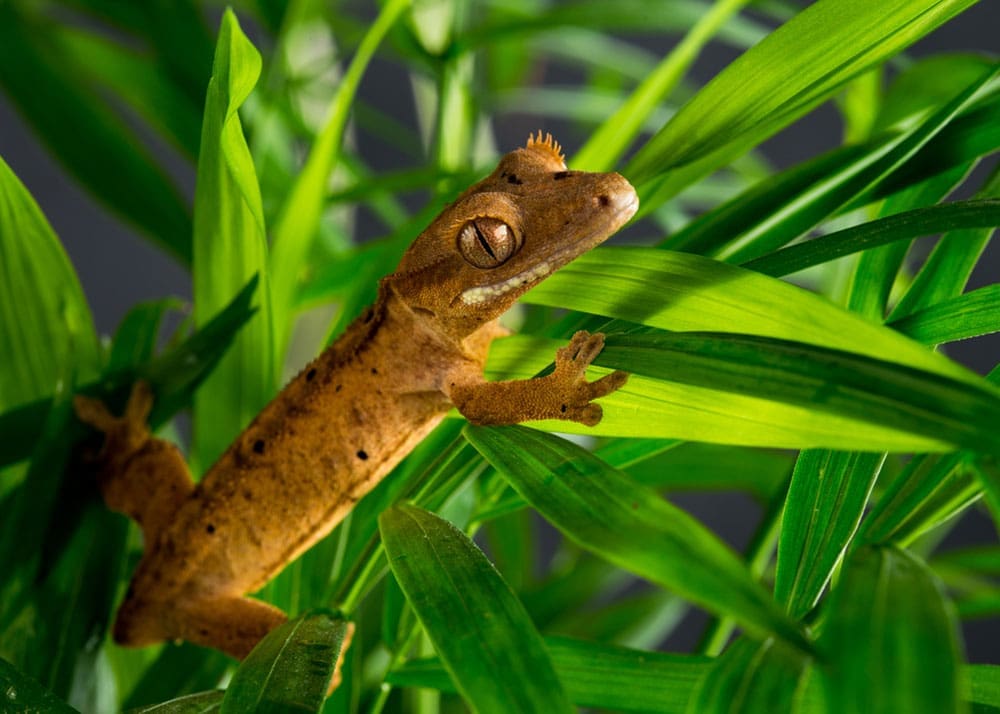Care Sheet: Crested Gecko (Correlophus ciliatus)
Natural History and Biology
Crested Geckos (Correlophus ciliatus) originate from the islands of New Caledonia in the western Pacific, where they live in cool rainforests. Hatchling Crested Geckos are around 5–6 cm in length and mature into adults approximately 20–24 cm long. Well-fed animals will reach maturity between 12–18 months of age. Longevity under captive conditions is quite variable, with 8–12 years being the norm, though double this is occasionally achievable. The typical wild-type Crested Gecko is relatively patternless, with varying shades of brown and grey. However, all specimens available as pets originate from captive-bred stock and come in a wide variety of colours and patterns, also known as morphs, including deep reds, oranges, and yellows, with spots, stripes, or chevron markings down the back, to name but a few variants. They have small scales that give their skin a smooth, velvety texture with an obvious crest leading from the eyes past the neck. They also have a fringe around their eyes. Like most arboreal geckos, they have pads at the end of their feet, allowing them to readily cling to vertical surfaces.
Crested Geckos do not normally bite and can be handled easily. They are quite flighty, however, and will often jump, especially when younger. It is best to restrict handling of newly acquired specimens and young animals until they are comfortable being handled. Care must always be taken when handling them, as they will readily shed their tail, which will not regrow if lost. In fact, wild geckos rarely retain their tails into adulthood as they are extremely quick to drop it if they feel threatened.
When choosing a Crested Gecko, look for an animal that appears alert and, when moving, holds its head and body well above the ground. It should have clear, bright eyes. Its nostrils and mouth should be free of discharge. The tail should appear rounded, and the body should be well filled with little evidence of excess skin folds (sometimes referred to as poverty lines). Check its enclosure and examine the faeces—they should be solid, dark brown with a small white tip, without any signs of diarrhoea.
Housing
In the wild, Crested Geckos typically live in loose groupings of a male and one or more females, sharing the same tree. In captivity, Crested Geckos can live happily on their own. If you plan to house them in groups, the size of the enclosure is crucial. When keeping a male and female pair, consider moving the male to a separate enclosure after mating to allow the female time to recover from egg-laying. Female pairs or groups can also be housed together, but each gecko should have enough space to avoid territorial disputes. Two adult males should not be kept together, as fighting and injury are likely.
An enclosure for a single Crested Gecko should be at least 45 x 45 x 60 cm, though larger is preferable, especially for groups. Since Crested Geckos are arboreal, the enclosure should have more height than width or length. Glass terrariums are the most popular choice, as they hold humidity well without being damaged. Wooden vivariums can also be used, but they must be waterproofed with an animal-safe sealant to prevent deterioration from moisture over time.
Substrate
A variety of substrates can be used when housing Crested Geckos. At Blue River Diets, we choose ProRep “Crestie Life,” which is a perfect blend of different organic components. However, orchid bark and coconut fibre are also popular choices, either used on their own or mixed with sphagnum moss. Whichever substrate is used, it should be kept slightly damp to maintain the humidity in the enclosure at about 65–80%. A shallow water dish and regular spraying will also help to maintain the correct humidity. Good ventilation is essential to prevent stagnant conditions, which could lead to disease.
Providing climbing and resting facilities is crucial for Crested Geckos. Natural or artificial vines, cork bark tubes, and a cork bark background will offer ample climbing space and enrichment. Bioactive enclosures are also a popular choice. These setups include live plants and detritivore insects, creating a self-sustaining environment. Plants naturally help to maintain humidity and provide hiding spots for your gecko. If you choose a bioactive setup, ensure that the plants are sturdy enough to support an adult gecko without damage. For more information on bioactive enclosures, visit a reputable reptile specialist store or check guides available online.
Heating
Crested Geckos thrive at moderate temperatures, and overheating is more problematic than being too cool. Ideal daytime temperatures range from 23–25°C, with nighttime drops to 15–18°C. This temperature drop is beneficial for these geckos. Heating can be provided through ceramic heat emitters, infrared heat projectors, or low-wattage heat lamps, all controlled by a thermostat to prevent overheating. If using a light-emitting heat source, it must be turned off at night to allow for at least 12 hours of darkness. To ensure proper temperature gradients, place thermometers at both the warm and cool ends of the enclosure.
Lighting
Crested Geckos are nocturnal but should be provided with UVB lighting. The provision of a Zone 1 UVB tube will support the animal’s circadian rhythms and other aspects of their wellbeing, resulting in healthier animals and better success rates when breeding.
Feeding
In the wild, Crested Geckos feed on a wide variety of items, including soft, overripe fruits and insects. In captivity, breakthroughs in product development have led to products such as Blue River Diets, which provide everything the animal needs in one easy-to-mix formula. In this case, additional supplements are not required. However, if the keeper chooses to use different brands, they must pay careful attention to the ingredients and ensure that supplementary vitamins and calcium are used where necessary. Without the correct vitamins, minerals, and calcium, Crested Geckos can suffer from Metabolic Bone Disease (MBD). Live foods should also be provided alongside Blue River Diets, as they allow the gecko to exercise while chasing prey across the enclosure. Locusts, crickets, Dubia roaches, and silkworms all make excellent prey items. Hatchling Crested Geckos should be offered small amounts of food either every day or every other day during their early growth stages. Once they reach around six months, feeding should be reduced to every 2–3 days. Reptile metabolism differs greatly from that of mammals and is generally much slower.
Breeding
During winter, the temperatures in the vivarium should be dropped slightly and the day length reduced. In the spring, the daylight and temperature are returned to normal, which will trigger breeding. As the females develop eggs, a suitable egg-laying site should be provided, filled with damp moss, peat moss, or potting compost, and checked regularly for eggs. Once laid, the eggs should be placed into a container of dampened vermiculite or another suitable incubation medium and incubated at temperatures between 24–26°C. At these temperatures, hatching should occur in around 60–70 days, resulting in a mix of male and female offspring.
Health
When cared for correctly, Crested Geckos do not suffer from many serious illnesses. Some common health issues include:
Impaction: Impaction occurs when a blockage forms in the digestive tract, often from substrate ingestion. Though the impaction is caused by the substrate, the underlying cause should be investigated, such as calcium deficiency, inappropriate feeding practices, improper enclosure setup, dehydration, or improper humidity. Regular monitoring of the gecko’s enclosure and meeting its dietary needs are key to preventing impaction.
Metabolic Bone Disease (MBD): This occurs when the animal does not receive enough calcium or Vitamin D, causing the bones to bend and twist as they grow. Once the bones are deformed, they cannot be corrected, and the animal will be crippled for life. A good regime of vitamin supplementation and correct UVB lighting can prevent this disease from developing or worsening.
Incomplete Skin Sloughing: This is usually caused by keeping the gecko too dry. Correcting the humidity will usually cure the problem, but if a lot of skin is stuck, the animal should be placed into a small container with damp moss overnight. This will soften the stuck skin and allow the animal to remove it. If the skin remains stuck, you can gently remove it with tweezers, but be extremely careful not to damage the animal’s skin, particularly around the toes or eyes. If the skin does not come away freely, do not continue attempting to remove it.
Floppy-tail Syndrome: Crested Geckos can be prone to this condition, which is likely caused by insufficient calcium and/or a lack of adequate climbing and arboreal resting décor. Further research is needed to fully understand this condition.


